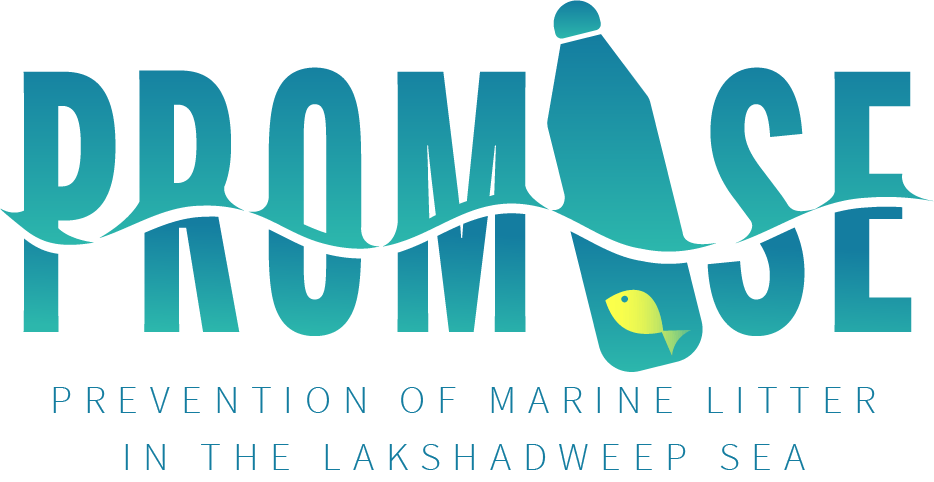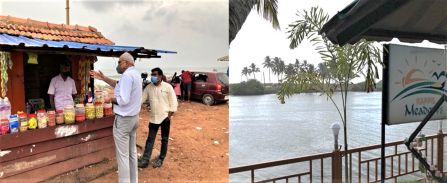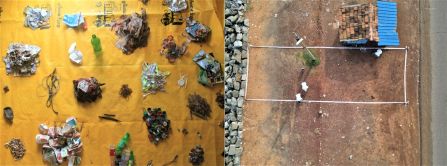INDIA: Pilot Material Flow Analysis in Paruvar Beach, Kerala
| Date |
Date
|
Overview of Activities:
The ‘Prevention of Marine Litter in the Lakshadweep Sea (PROMISE)’ project conducted its pilot Material Flow Analysis (MFA) in Kerala, India. The project team from Adelphi research GmbH and STENUM Asia developed a data collection methodology in June 2021 and carried out their pilot MFA in November 2021. Paruvar Beach, Kerala (8°47’31.2’’ N, 76°40’07.9’’E) was identified as a suitable location to pilot both manual sampling and collection of imagery sampling via drone.
The MFA consists of three key data collection activities:
1. Collection of HD imagery data via drone for the entire beach
2. Manual collection of wase from three representative segments of the beach
3. Interviews with focus groups
The results of the drone survey were then interpolated with the data collected from the three manual samplings to quantify the total amount of waste present on the entire beach. The litter from each segment (size 10x5 meters) was collected in a plastic bag and marked. Then, the team categorized the material collected in groups based on its nature and use (i.e., plastic bottles, cigarette buts, paper and cardboard, etc.). Once the segregation was concluded, the different waste groups were counted and weighted.
Key Observations:
The surveyed beach area was classified into segments based on pollution levels namely: high polluted segment, medium polluted segment, and low polluted segment. Manual sampling and drone imagery analysis were analysed based on these segments. This resulted in more than 93,000 items being present on the analysed 430.7 meters of Paruvar Beach for a total weight of around 300 kilograms.
The manual and aerial samplings allowed the PROMISE team to collect insights regarding the type of waste present on the beach location. The analysis showed that the most common waste types present on the Paruvar Beach are plastics, paper, and glass. Of these, the majority can be considered disposable items. The waste collected was categorised by material and can be seen in the image below:
Outcomes of Stakeholder Interviews:
The STENUM Asia Team conducted a total of 10 interviews with different focus groups active in the pilot area on the 9th and 10th of May 2022 in order to gauge the waste management behaviours, the most generated type of plastic waste, and their leakage points.
When three cart vendors from the Puvar beach area were interviewed, they found that there was no formal waste collection system in play. Due to the absence of waste bins, the customers throw the waste (ice cream boxes, sticks and wrappers) around the vendor stall. There was also no regulation on waste generation or the amount of single-use plastics sold. Occasionally, volunteers would come to collect glass and plastic wastes as part of clean-up activities, but there was no municipal effort. Given the absence of a structured collection system, some of the vendors gather their waste and burn them together on Sunday evenings. However, one of the expressed interest in using bio-based cups (areca or banana leaf) if they became more affordable.
However, discussions with restaurant owners revealed that plastic waste is separated and stored until it is collected by the municipality once or twice per month. High-value plastics such as PET bottles are sold to a nearby waste collector, and the food waste generated by the restaurants was composted.
Conclusions and Lessons Learnt:
The MFA study shows that there are several sources of municipal solid waste and through some waste management activities the waste is either sent for processing or leaks out to the environment. The majority of the waste collected during sampling can be considered disposable items. For example, PET plastic bottles caps, disposable cutleries, and multi-layer packaging were found in high numbers in all three sampled transects. Furthermore, cigarette butts and glass bottles (or fragments of them) were also very common.
Recyclable material such as PET bottles in a meaningful quantity was not found during the sampling. This is perhaps due to the frequent collection of PET bottles along the road and beaches by the informal waste collectors, as they can get revenue from such items that they consider commensurate with the effort invested in the collection of the waste. Items that do not generate revenue commensurate to the effort for collection simply do not get picked up by the informal waste collectors.
The solid waste management practices in the Varkala and Paruvar beaches require further fine-tuning by capacity building and awareness raising at municipal and SMEs respectively. With the existing infrastructure already in place a more effective waste management system ought to be achieved. The small gaps that exist can perhaps be fixed at low cost yet yield high impact.
Further discussions about the lack of waste collection and waste management system at Paruvar beach revealed that the beach lies at the border of two districts. Neither of the two districts considers this beach as their responsibility hence, leaving it to the other district to operate waste management services at Paruvar. This lack of administrative support from the local authorities is perhaps leading to high levels of waste littering on the beach and also to the practice of waste incineration by the local SMEs / cart vendors.





